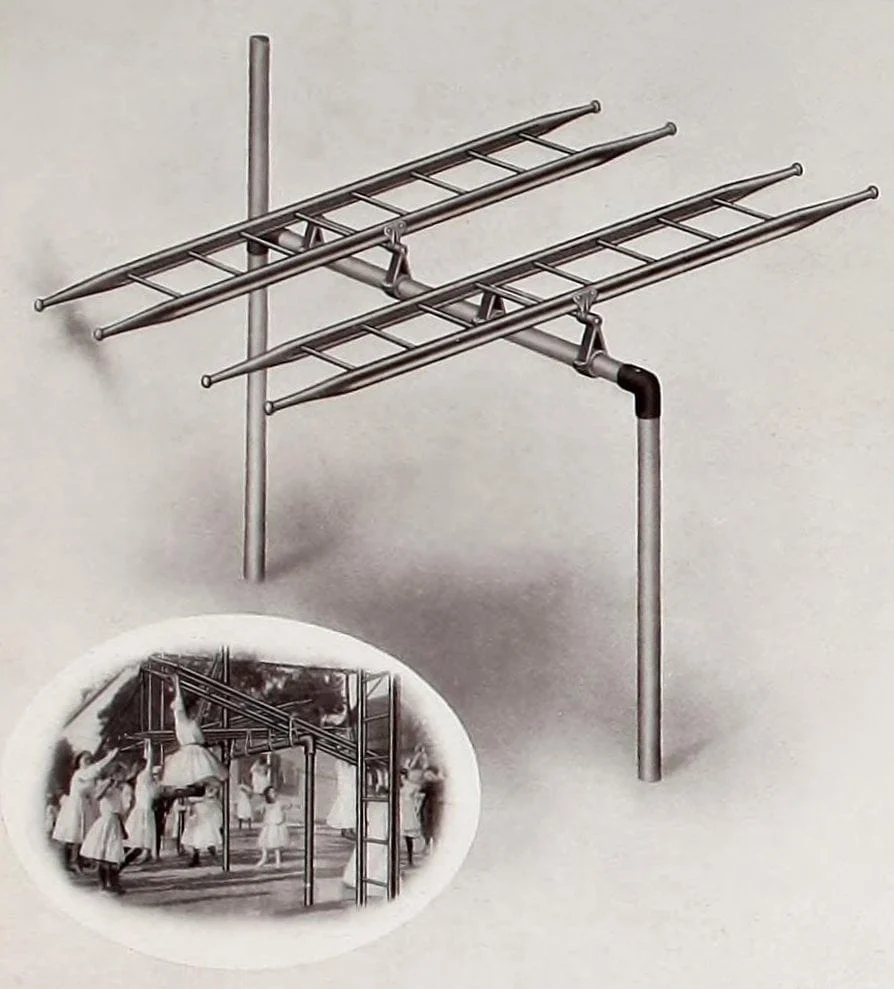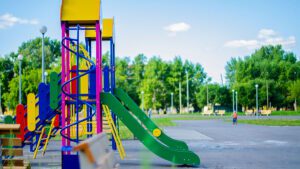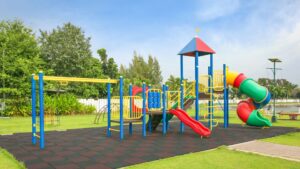El equipamiento de los parques infantiles ha evolucionado considerablemente a lo largo de los años, dando prioridad a la seguridad de los niños y garantizando al mismo tiempo que el tiempo de juego siga siendo divertido y educativo. Si echa un vistazo a los equipos de parques infantiles prohibidos a lo largo de los años, se dará cuenta rápidamente de lo lejos que hemos llegado en términos de diseño, seguridad y materiales. Los diseños anticuados y los materiales peligrosos provocaron numerosas lesiones, y estas mejoras reflejan nuestro compromiso de crear espacios más seguros para los niños. En este artículo, nos adentraremos en los diez elementos más extraños de los parques infantiles que fueron prohibidos y analizaremos por qué se consideraron peligrosos.
Por qué se prohíben los juegos infantiles
El equipamiento de los parques infantiles ha experimentado cambios drásticos a lo largo de la historia, y una de las fuerzas motrices más significativas ha sido la mayor atención prestada a la seguridad de los niños. Los parques infantiles antiguos contaban con equipos a menudo inseguros, con materiales peligrosos como suelos de hormigón y estructuras metálicas que provocaban un alto índice de lesiones.
En el pasadoEn el siglo XIX, las normas de seguridad eran a menudo mínimas, y muchas estructuras de los parques infantiles carecían de pruebas reales de seguridad antes de colocarse en escuelas y parques. Por ejemplo, los columpios con columpios altos y materiales duros solían ser algo habitual, pero estos peligrosos diseños a veces causaban graves accidentes.
Hoy en día, las normas de seguridad son mucho más estrictas, y los equipos requieren la aprobación de organismos como la Comisión Europea. Comisión para la Seguridad de los Productos de Consumo (CPSC) antes de poder acceder a las zonas de juego infantiles. Estas normas han dado lugar a mejoras significativas, haciendo que los parques infantiles sean más seguros y accesibles para niños de todas las capacidades.
Historia y evolución de los parques infantiles
Los primeros parques infantiles tenían diseños sencillos, como barras de mono, tiovivosy oscilaciones de troncos. Sin embargo, muchos de estos equipos se construyeron sin tener en cuenta la seguridad, y a menudo contenían bordes afilados o estaban fabricados con materiales duros y peligrosos, como el hormigón.
Con la introducción de nuevas pruebas de seguridad, el diseño de los juegos infantiles ha cambiado drásticamente. Por ejemplo, los equipos fabricados con pintura con plomo y metales peligrosos se ha sustituido por materiales más duraderos y respetuosos con los niños como mantillo de caucho y virutas de maderaque ayudan a absorber los impactos y reducen el riesgo de lesiones.
¿Por qué se prohíben los juegos infantiles?
Los juegos infantiles se prohíben por varias razones, pero la principal es la seguridad. En décadas pasadas, los juegos infantiles no se sometían a pruebas sustanciales antes de colocarse en espacios públicos. Como hemos aprendido de numerosos accidentes, los diseños antiguos carecían a menudo de características esenciales como superficies amortiguadoras y materiales adecuados que pudieran minimizar el riesgo de lesiones.
Por ejemplo, parques infantiles de madera dominaron en su día muchos parques, pero han caído en desuso porque provocaban astillas y requerían un mantenimiento exhaustivo. Igualmente, hormigón superficies, gravay pesado metal componentes planteaban riesgos como conmociones cerebrales, abrasionese incluso envenenamiento en el caso de las pinturas con plomo. La necesidad de parques infantiles más seguros y bien mantenidos ha impulsado cambios significativos en el diseño de estos espacios.
Los diez juegos infantiles más prohibidos
A continuación repasamos diez de los elementos más peligrosos y extraños de los parques infantiles del pasado. Estos artículos se prohibieron no solo por sus extraños diseños, sino también por los importantes riesgos que entrañaban para la seguridad.
1. Puertas giratorias
Las puertas giratorias eran un elemento popular pero muy peligroso en los parques infantiles. La puerta estaba sujeta a un solo poste, y los niños se agarraban a una barra mientras intentaban balancearse alrededor del poste. Sin una plataforma segura, los niños corrían el riesgo de caerse e incluso de pillarse los dedos de los pies con los listones. Las pesadas puertas, a menudo metálicas, suponían un riesgo de lesiones, lo que las convertía en uno de los principales peligros de los parques infantiles.
2. Zancadas gigantes
Las Zancadas Gigantes, inspiradas en la tradición del palo de mayo, consistían en un gran poste vertical con cuerdas atadas a él. Los niños corrían alrededor del poste e intentaban saltar por los aires para volar brevemente. Sin embargo, el diseño requería mucha coordinación y trabajo en equipo, y muchos niños chocaban entre sí o con el poste, lo que provocaba abrasiones y lesiones graves.

3. Balanceo de troncos
El columpio de troncos era básicamente una larga viga de madera o metal que los niños balanceaban hacia delante y hacia atrás. ¿El problema? Podía balancearse fácilmente de un lado a otro de forma imprevisible, sobre todo cuando varios niños se amontonaban en él. La falta de control y la pesadez del columpio provocaban graves accidentes, a menudo con niños chocando entre sí o con la propia estructura.
4. Escalera Teeter
La Teeter Ladder, una combinación de jungle gyms y balancines, era una estructura formada por dos escaleras sujetas a una barra horizontal. Cuando los niños subían las escaleras, la barra se inclinaba, provocando un movimiento brusco y potencialmente peligroso. Este equipo provocaba a menudo caídas y lesiones, sobre todo cuando los niños perdían el agarre o la coordinación.

5. Columpio de seguridad Poised
Pensado para lanzar a los niños con seguridad a una piscina, el columpio de seguridad Poised era mucho más peligroso de lo que sugería su nombre. El diseño del columpio consistía en una escalera alta por la que los niños subían antes de columpiarse en el agua. Sin embargo, a veces el mecanismo fallaba y los niños caían desde gran altura. La posibilidad de que el columpio dañara al usuario o a otras personas a su alrededor llevó a su prohibición.

6. Toboganes Racer
Los toboganes de carreras eran toboganes altos de metal diseñados para satisfacer el deseo de velocidad de los niños. Sin embargo, estos toboganes no sólo eran estrechos, sino también extremadamente peligrosos. Los niños se resbalaban a menudo, y los toboganes se calentaban peligrosamente en verano, provocando quemaduras. La gran altura de estos toboganes también suponía un riesgo importante de lesiones al aterrizar.
7. Sombrero de bruja
El Sombrero de Bruja era un tiovivo con un poste central y una estructura giratoria. Los niños podían correr alrededor de la estructura o agarrarse a ella mientras giraba. Sin embargo, el riesgo de caer a través de la estructura, quedar atrapado o golpearse contra el poste a gran velocidad lo convertía en una pieza insegura. Hoy existen versiones con diseños más seguros que evitan las caídas y tienen velocidades de rotación más lentas.
8. Columpios para animales
Estos columpios tenían forma de animales, como patos o gallinas, y solían ser muy coloridos. Aunque divertidos en apariencia, eran muy pesados y difíciles de controlar. Los niños solían lesionarse al golpearse o chocar con otros niños. Además, su pesada construcción metálica los hacía peligrosos, sobre todo cuando los niños se golpeaban con ellos.
9. Barril de diversión
El barril de la diversión consistía en un gran barril que giraba alrededor de un poste central. Los niños intentaban agarrarse al barril mientras giraba o hacían piruetas como saltos mortales. A menudo, el barril alcanzaba velocidades peligrosas, lanzaba a los niños y les causaba lesiones. La dura superficie de hormigón sobre la que se asentaba también lo convertía en una opción insegura.
10. Tobogán gigante (Racer Slide)
Estos enormes toboganes metálicos eran habituales en muchos parques infantiles a mediados del siglo XX. Aunque la emoción de deslizarse a gran velocidad entusiasmaba a muchos niños, estos toboganes eran estrechos, estaban hechos de metal caliente y planteaban riesgos considerables. El peligro de caerse del tobogán o de aterrizar incorrectamente en una superficie dura hizo que estas estructuras acabaran desapareciendo.
El impacto de los equipos prohibidos en los parques infantiles modernos
La prohibición de estas estructuras ha dado forma a los parques infantiles actuales. Los parques infantiles modernos cuentan ahora con equipos más seguros y accesibles, diseñados para evitar lesiones. Equipos como el muro de escalada, columpios de gomay balancines invertidos proporcionan las mismas emociones sin riesgos. Los diseños de los parques infantiles también dan prioridad a la inclusión, ofreciendo características como columpios accesibles en silla de ruedas y estaciones de transferencia garantizar que todos los niños, independientemente de su capacidad, puedan disfrutar del patio de recreo.
El papel de la tecnología en la seguridad de los parques infantiles
La tecnología ha desempeñado un papel importante en la seguridad de los parques infantiles modernos. Con las innovaciones en materiales y elementos de seguridad, como superficies de absorción de impactos y materiales para columpios más segurosLos juegos infantiles son ahora más duraderos y seguros que nunca. Los avances en el diseño han dado lugar a mejores sistemas de control que ayudan a identificar y abordar posibles problemas de seguridad antes de que se produzcan accidentes.
Además, herramientas tecnológicas como sistemas de vigilancia basados en sensores y puertas de seguridad para niños han contribuido a garantizar que los parques infantiles sigan siendo seguros para todos los niños. Gracias a estos avances tecnológicos, los parques infantiles ofrecen hoy en día una experiencia no sólo divertida, sino también mucho más segura.
Conclusión
Con el paso de los años, las normas de seguridad de los parques infantiles han avanzado mucho. Aunque los diseños de muchos parques infantiles antiguos pueden parecer divertidos e innovadores, a menudo eran inseguros y provocaban frecuentes lesiones. Hoy en día, la seguridad y la accesibilidad son las máximas prioridades en el diseño de parques infantiles. A medida que sigamos desarrollando mejores materiales y tecnologías, los parques infantiles serán cada vez más seguros, proporcionando a los niños un entorno divertido y seguro para jugar y crecer.




